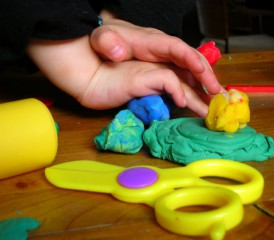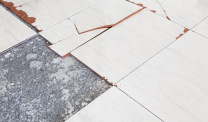Are Children Safe from Asbestos Lurking in Their Crayons, Toys?
Asbestos Exposure & BansWritten by Tim Povtak | Edited By Walter Pacheco

Recent reports of deadly asbestos discovered in crayons serve as a grim reminder that children may come in contact with the toxic substance where parents least expect it, their toys.
Independent tests commissioned by the Environmental Working Group Action Fund (EWG) revealed that several toys manufactured in China and imported to the U.S., including crayons and amateur crime lab kits, contained asbestos fibers.
“Even if the absolute risk is relatively low, children are more vulnerable to toxic material and carcinogens,” said Dr. Richard Lemen, former U.S. Assistant Surgeon General and now a professor at Emory University Rollins School of Public Health in Atlanta. “These are important findings because asbestos is being placed in children’s products. And because they are so young, they have a longer latency in which to develop these diseases.”
Asbestos is a known carcinogen responsible for the development of several deadly respiratory diseases such as asbestosis and mesothelioma, which can take 20-50 years to develop after first exposure.
But this isn’t the first time asbestos is found in children’s toys. Over the last several years, investigators found the deadly mineral in other crayons, crime-scene kits and modeling clays.
Asbestos in Crayons
The microscopic asbestos fibers were found in four of the 28 boxes of crayons that were tested, and two of the 21 crime-scene fingerprint kits.
EWG officials commissioned government-licensed Scientific Analytical Institute (SAI) of Greensboro, North Carolina, to test the crayons and crime-scene kits earlier this year.
“I was shocked at the results,” Sean Fitzgerald of SAI informed EWG officials. “This testing confirms that products sold off the shelf may still contain some level of asbestos. Although this testing found asbestos in imported products, domestic products should also be considered suspect.”
According to the EWG report, tremolite or chrysotile asbestos fibers were found in:
- Inside Intelligence Secret Spy Kit (Buy-Rite)
- EduScience Deluxe Forensics Lab Kit (Toys “R” Us)
- Saban Power Rangers Super Megaforce Crayons (Greenbrier International)
- Disney Mickey Mouse Clubhouse Crayons (Greenbrier International)
- Nickelodeon’s Teenage Mutant Ninja Turtles Crayons (MII Inc.)
- Amscan Crayons (Amscan)
The U.S. Consumer Product Safety Commission (CPSC) regulates asbestos in many products, but it has no policy on asbestos in crayons. CPSC officials said they are investigating the recent EWG report.
Earlier Reports of Toys Contaminated with Asbestos
This was the third time in the last 15 years that asbestos fibers were uncovered in children’s products by a licensed laboratory.
A 2000 study first exposed the presence of asbestos in crayons.
The CPSC investigated and determined the presence of asbestos was “scientifically insignificant.” And even if a child would eat the crayon, the fibers in the wax would pass through the body before separating.
Tests commissioned in 2007 by the Asbestos Disease Awareness Organization (ADAO) uncovered asbestos in a toy fingerprint kit named after the television series CSI: Crime Scene Investigation. The toy, which was made in China, was removed from the shelves by the company that made it.
In 2009, the ADAO settled a class-action suit against CBS and major retailers, which agreed to remove the crime-scene kits from store shelves and give refunds to purchasers.
Those tests also indicated the presence of asbestos in ArtSkills Clay Bucket and Ja-Ru Toy Clay, according to the EWG.
Officials did not implement any new asbestos regulations regarding crayons or toys after either of the previous reports.
Talc Is Often the Culprit in Asbestos Contamination
The contamination was linked to talc each time that asbestos was found in these toys.
Talc serves as a binding agent for the crayons and was found in the powder used in the crime-lab fingerprint toys.
Asbestos, a naturally occurring mineral often found in mines alongside talc deposits, has caused health concerns in the past. Although asbestos is no longer mined in the U.S., it remains popular.
Talc, one of the world’s softest minerals, has been mined from deposits interwoven with traces of asbestos. Talc is used in many products today, including cosmetics and pharmaceuticals. Talc power is regularly used to absorb moisture and improve feel.
It also is used regularly in rubber, chalk and ceramics.
Although the link between asbestos and talc has been debated for decades, it has been strong enough to hold up in court. A California woman in 2013 won a $13 million lawsuit against Colgate-Palmolive when a jury said the company’s talcum powder laced with asbestos was responsible for causing her mesothelioma.
The use of asbestos has dropped significantly in recent decades, but it remains legal in the U.S. for certain purposes, including roofing materials and friction products like automobile brakes. Its ability to strengthen and fireproof most products made it
invaluable to the construction and shipbuilding industries throughout much of the 20th century.
No Safe Level of Asbestos
The policy of the U.S. Occupational Safety and Health Administration (OSHA) is that there is no safe level of asbestos exposure, yet it requires a measurable minimum of 1 percent of a material to be listed as “asbestos-containing material.”
The recent EWG report did not specify the amount of asbestos found in the products. It did say the crime scene fingerprint kits presented more of a problem than the crayons because the powder used was more easily inhalable by children.
There was no mention of asbestos as part of a warning label on any of the products that were tested for the latest study.
“The lesson here is that parents can’t just read labels and choose safer products by looking at the labels themselves,” said Sonya Lunder, an EWG senior researcher. “There’s not enough information about where asbestos might be found.”
The legality of asbestos use has been debated for years. The U.S. Environmental Protection Agency (EPA) issued a strict
ban in 1989 on most asbestos-containing products, but the regulation was overturned in 1991. Congress has not passed a law banning asbestos specifically in products used by children.
The overwhelming majority of asbestos-related disease cases stem from occupational exposure. There is a
small number of documented cases involving children who were exposed by working parents who inadvertently brought home the asbestos, or children exposed in a home under construction or in disrepair with asbestos products exposed.
There never has been a documented case of a child diagnosed with an asbestos-related disease stemming from crayons or other children’s toys, but with the long latency period between exposure and diagnosis, it would be extremely difficult to diagnose.
“This is an exposure that could easily be avoided,” Lunder said. “The threshold for exposing a kid to a carcinogenic chemical when they’re playing with toys should be zero.”






